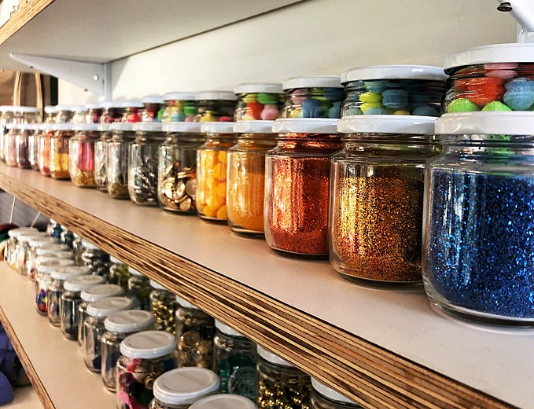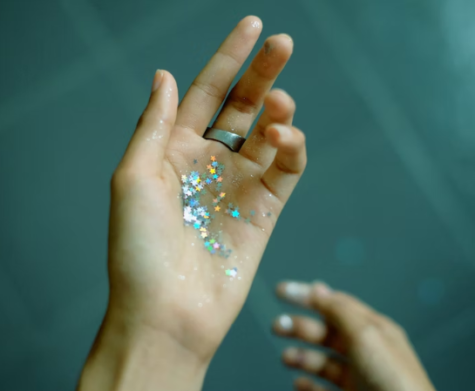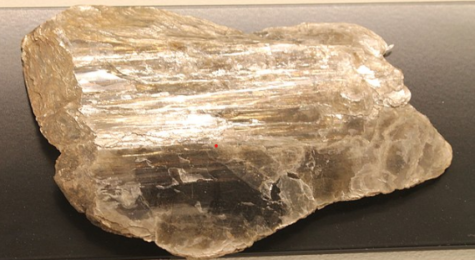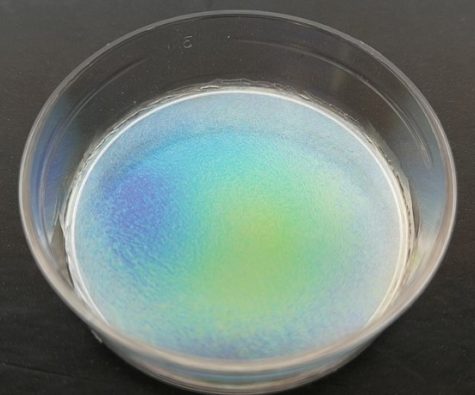The Not-So-Glamorous History of Glitter
A single fleck of plastic glitter, although small, can take decades to break down. Why not consider some alternatives that are much better for the environment and can give you the same shine?

GiFontenelle, CC BY-SA 4.0
Cellulose glitter is a great alternative to plastic glitter as it can come in a variety of shapes and sizes. However, since cellulose glitter is relatively new, it is difficult to find it in craft stores. Instead you can purchase cellulose glitter online.
Everyone has encountered glitter in one form or another: slime, Christmas ornaments, makeup, or the glitter glue from your first grade art projects. Glitter has been around since 1934 and has captivated the world ever since, but its environmental impacts are quite grave. Unsurprisingly, these shiny speckles are made up of one of nature’s greatest enemies, plastic. The majority of glitter is made with a plastic called polyethylene terephthalate (PET) and coated with aluminum for its characteristic shine.
Glitter is notorious for its remarkable ability to stick to skin and often seems to appear out of nowhere. Your first instinct may be to wash off that pesky flake in the sink or shower, but due to its size, glitter can easily pass through wastewater treatment facilities and make its way into the ocean.

When you think of plastic pollution and large garbage patches in the ocean, you probably envision plastic water bottles, disposable masks, plastic bags, gloves and clothes. Although less visible, glitter is also present in oceans and can be consumed by sea creatures, thus moving through the food chain.
“Plastic glitter is very pretty and fun to use. However, it isn’t the best for the environment since it is technically a microplastic. I try not to use plastic glitters but I have to admit, I do love the way they look,” said Ashmita Sarker ’24.
Admittedly, glitter is great at highlighting and making things appear more beautiful, but is it necessary in certain products? The answer is no, as glitter is entirely superficial to most objects. Nonetheless, considering the toll it has on the environment, we need to draw a line on what should be glitter-fied.
“I think companies should focus on creating and then advertising biodegradable and more ethical glitter,” said Elizabeth Guerrero ’24.
Even though individuals can choose not to buy glitter or objects containing glitter, it is ultimately up to the manufacturers to use alternatives. This doesn’t mean that companies should no longer make products with glitter — rather, they should focus on creating new items with substitutes.
While removing glitter is the long-term solution, gradually phasing out plastic glitter is the best option for now. But fear not! There are multiple substitutes that are more environmentally friendly and less potentially dangerous.
Mica
One glitter substitute, mica, is a category of minerals that are characterized as flaky, incredibly brittle, slightly lustrous, and a good electrical insulator. The mineral has a variety of uses ranging from electronics to soap. It is typically harvested through open pit mining (when mica is close to the top layer of soil) or shaft mining (where drills are required to remove the mineral). There are mica mines all over the world, including Finland, China, India, Madagascar, and the United States.
Areas like Jharkhand, India, are filled with shimmery soil that is rich with mica. Unfortunately, much of the mica mining in India and Madagascar is unregulated by the government, thereby allowing children as young as five to take part in this arduous job. Children are preferred in this field because of their smaller stature, which makes it easier for them to access larger mica flakes underground.
Children go into pits and use mattocks, a hand tool similar to pickaxes, to scrape soil into a pan. Once they fill their pans, they carry them above ground where other children filter the soil for mica. The resulting mica is put into bags and sold at relatively low prices to be processed by manufacturers.

Mica mined using child labor is dubbed “blood mica” because of the unsafe conditions workers are subjected to. These include lung scarring, shortness of breath, tunnel collapses, and even death. Mica isn’t entirely safe for the consumer, either. Mica runs the risk of being contaminated with asbestos, a carcinogenic mineral. However, that risk is negligible. Another factor to consider is that mica has rough edges and can cause miniscule tears in skin which make your skin dry and flaky.
Children and their families often choose to work in mines because they need the (meager) income to scrape by. Jharkhand has high rates of poverty and manufacturers often exploit their workers by paying them by the amount of mica they procure. Refinery29 created a great video that goes in more depth about the mica industry and the child labor that is involved.
Although mica is a naturally occurring source of shimmer that is arguably environmentally better than plastic glitter, it is important to understand where your products come from and whether they were obtained using sustainable and ethical methods.
The Responsible Mica Initiative strives to promote better working conditions and eliminate child labor in mica mines in Jharkhand and Bihar. This initiative is supported by members and companies from a variety of industries including automotive and cosmetics.
Synthetic Mica
Synthetic mica, also known as Fluorphlogopite mica or artificial mica, are lab created versions of mica made with naturally occurring minerals. Some may have unfavorable views on synthetic mica because it is man-made, but it is also biodegradable.
Brands, especially cosmetic, love to market their products as “all natural” in order to attract a larger consumer base.
Synthetic mica is typically lighter than naturally occurring mica, which is gray. Therefore, synthetic mica can create brighter pigments and add more shine than natural mica. In addition, artificial mica doesn’t have the jagged edges that naturally occurring mica and plastic glitter have. Since synthetic mica is made and regulated in a lab, there is quality control and consistency over each aspect of the creation of synthetic mica. Opposed to naturally occurring mica, synthetic mica has little to no risk of asbestos contamination because the ingredients are screened for impurities before they are used. As a result, synthetic mica is safe for skin and is ideal for cosmetic manufacturers that want to add more shine to their products.
Many companies, like the cosmetic brand Lush, have been switching to synthetic mica because of the proposed benefits coupled with the fact that no child labor is involved in the development process. In other words, synthetic mica is another great alternative to traditional plastic glitter and can serve as a more ethical version of mica.
Cellulose Glitter

Cellulose glitter, which was developed in the past 3 years, provides a wide variety of colors just like traditional plastic glitter. Cellulose glitter can be created from any type of plant cellulose, ranging from the cellulose from wood to the cellulose from fruits. Cellulose glitter is biodegradable and is efficient since it can be made with food scraps and/or peels.
More specifically, cellulose glitter is created using the nanocrystals present in cellulose. The organic materials are mixed into a solution and spun around in a centrifuge-like machine. The necessary parts are separated and made into a paste. Then, the paste is cut into desirable glitter sized particles.
Companies that create cellulose glitter can create deals with different industries, like lumber mills to get saw dust, and minimize the amount of waste that goes into landfills. Cellulose glitter is edible and is good for cosmetic companies that want their products to maintain their “all natural” and “vegan” status.
Mica, synthetic mica, and cellulose are all great substitutes for plastic glitter that perform just as well, if not better. As consumers, choosing the right products can be difficult, but purchasing items that don’t have destructive plastic glitter can have an immense positive impact on nature and the wildlife.
As Isabella Tan ’24 said, “Glitter is pretty but also hurts the environment, so it’s really not worth using or buying.”
“Glitter is pretty but also hurts the environment, so it’s really not worth using or buying,” said Isabella Tan ’24.
Arianna Hwang is an Editorial Editor for ‘The Science Survey.' She enjoys reading and writing articles as she believes it is important to hear the opinions...
